Genus Tetramorium species-groups - Part 5
| The Ants of
Africa Genus Tetramorium species-groups - Part 5 |
|
| Tetramorium Introduction |
DIV3 QD2
Species groups
Part 5 - former Tetramorium (Tetramorium)
species with short antennal scapes, larger eyes and nodiform petioles
![]()
12-segmented
antennae (Tetramorium) |
|||
| Scape index < 100 (scape shorter than head width; usually does not reach occiput) | |||
| TD4 Eyes larger > 0.20 X HW, wider than maximum width of scape | |||
| Petiole not squamiform | |||
| SUB1 Lamellate appendage of sting spatulate or
linear Otherwise |
|||
| grassii-group | - | ||
| Complex-1 | Smooth mandibles; propodeal spines short; petiole node narrowed so no distinct dorsum | ||
| 63 | Propodeal
node rounded in profile; pronotal dorsum mostly smooth; TL 3.0 (3.6
mm?);
brownish rusty-red, head and gaster darker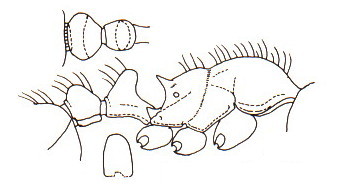 |
. | . |
| . |
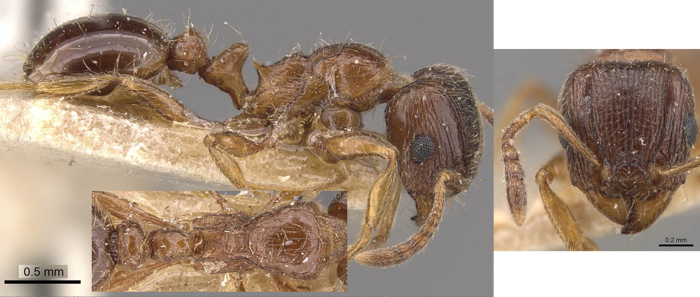 |
Tetramorium titus | South Africa |
| 63 | Propodeal node sharp-edged in
profile; pronotal dorsum rugulose; TL 3.7-4.3 mm; uniform dark brown 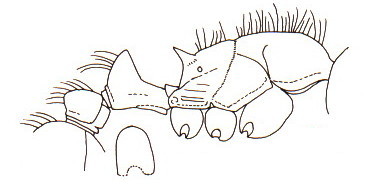 |
. | . |
| . | 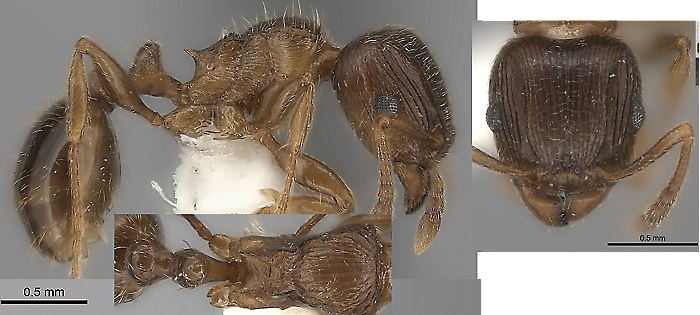 |
Tetramorium vexator | South Africa |
| Complex-2 | Striate mandibles; propodeal spines relatively long; petiole node not narrowed dorsally | ||
| 128 | Erect
hairs on dorsum of body plumose; TL 3.6-3.8 mm; uniform brown,
appendages lighter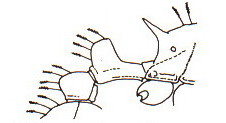 |
. | . |
| . |
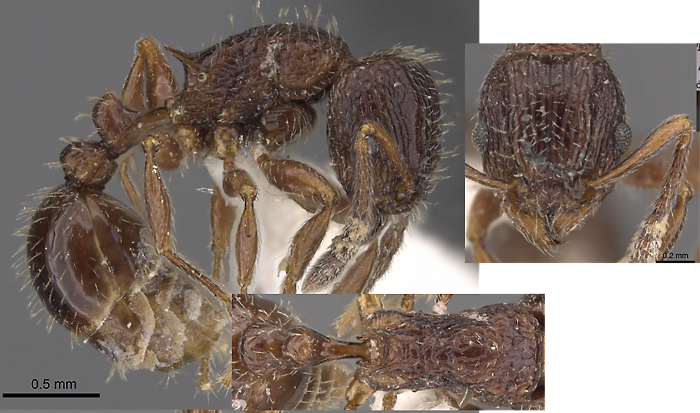 |
Tetramorium plumosum | Swaziland |
| 130 | Erect hairs on dorsum of body
fine and acute apically; TL 3.0-4.1 mm; uniform brown, variable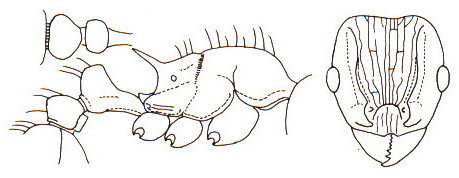 |
. | . |
| . | 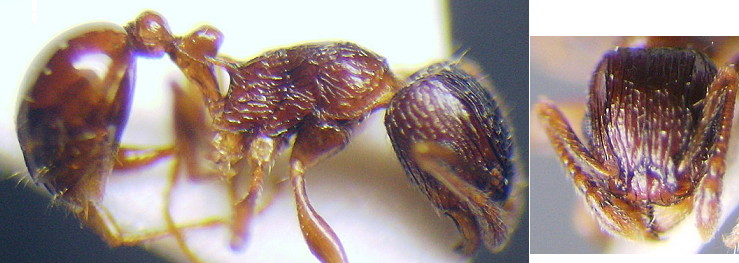 |
Tetramorium grassii | southern Africa |
| 130 | Erect
hairs on dorsum of body coarse, stout and blunt; TL 3.0-3.6 mm; uniform
yellowish brown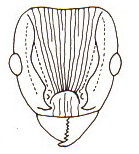 |
. | . |
| . |
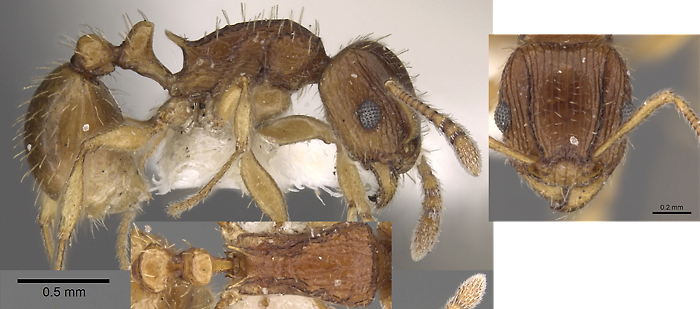 |
Tetramorium regulare | South Africa |
| SUB2 Lamellate appendage of sting dentiform, triangular or pennant-shaped | |||
| SUB3 Frontal carinae short,
ending ahead of posterior margin of eyes Otherwise |
|||
| Propodeum with a pair of
small teeth or denticles Otherwise |
|||
| ungrouped - former Atopula) | - | ||
| 61 | Elongated head, with short
scapes; propodeum with transverse rugulae; TL 4.4-4.6 mm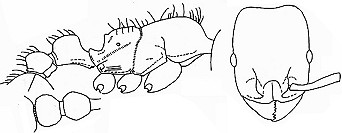 |
. | . |
| . | 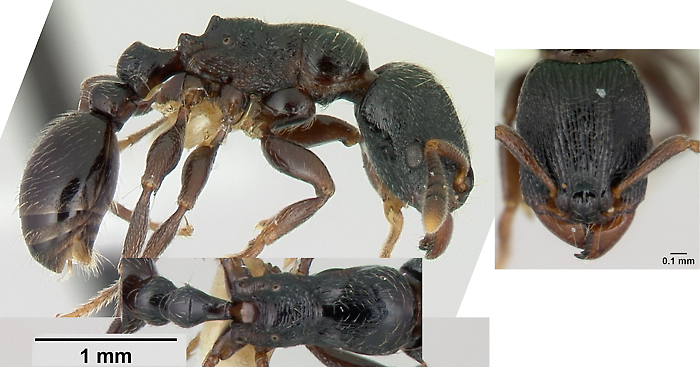 |
Tetramorium nodiferum | Ghana,
Cameroun, Kenya |
| Anterior clypeal margin
with median deep broad indentation or ventral head with ammochaete
hairs or both; all but one with ammochaete hairs; all relatively large,
TL > 3.7 mm Otherwise |
|||
| solidum-group | - | ||
| peringueyi-complex | With coat of abundant short erect hairs all over body and legs | ||
| 94 | Without
ammochaete hairs; antennal scapes without erect hairs; TL 3.7-3.9 mm;
brown but alitrunk more orange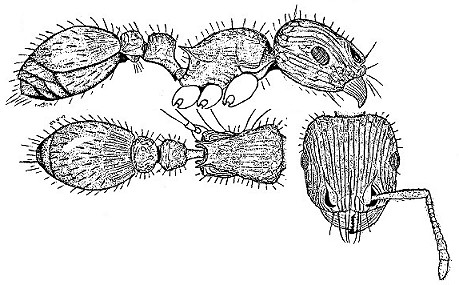 |
. | . |
| . | 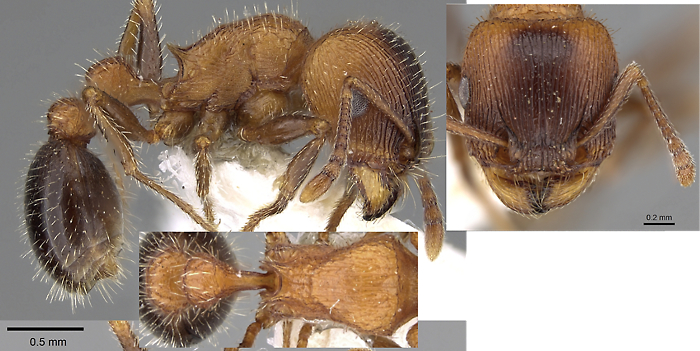 |
Tetramorium dichroum | South Africa |
| 94 | Antennal scapes with erect hairs
as on hind tibiae; TL 4.4-5.7 mm; orange-red to deep red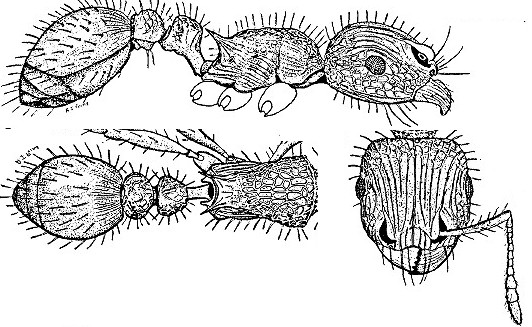 |
. | . |
| . | 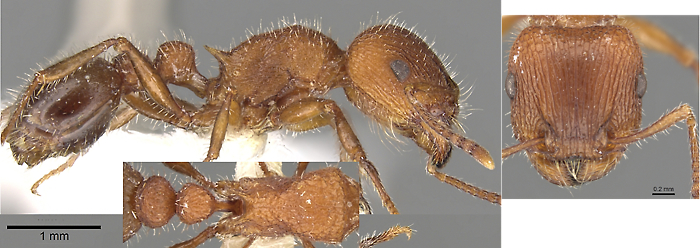 |
Tetramorium peringueyi | Botswana |
| setuliferum-complex | No erect hairs on dorsal surfaces of body but bizarre appressed pilosity | ||
| 31 | With
dense long strap-like silvery hairs, overlapping on vertex and
alitrunk; TL 5.1-6.0 mm; uniform red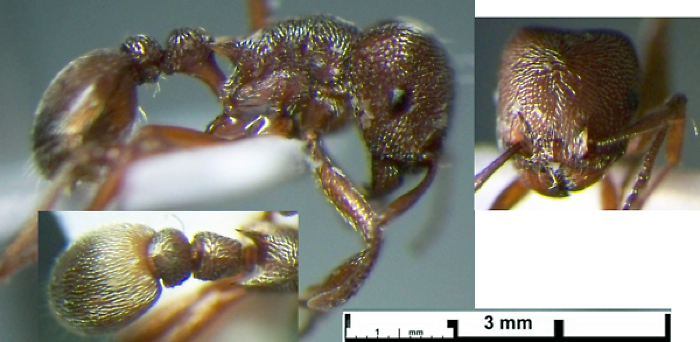 |
Tetramorium galoasanum | Congo |
| - | Appressed hairs sparse and spaced out, not strap-like or overlapping | ||
| 32 | In profile gaster with anterior
lower corner of first gastral tergite developed so as to overhang
sternite; TL 4.4-6.0 mm; uniform dull red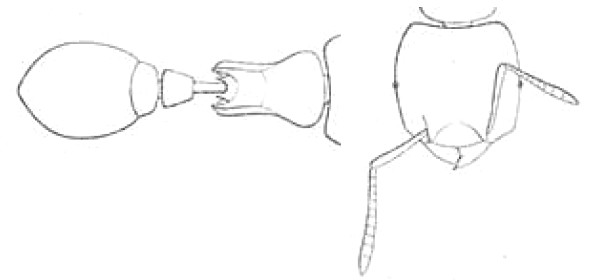 |
. | . |
| . |  |
Tetramorium setuliferum | East and southern Africa |
| 32 | Without
lobe on first gastral tergite; silvery hairs quite sparse; TL 3.9-4.6
mm; dull blackish brown to black; appendages reddish-brown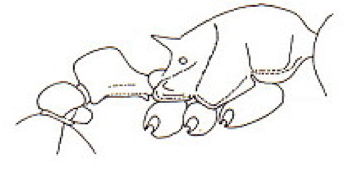 |
. | . |
| . |
 |
Tetramorium clunum | South Africa |
| solidum-complex | No erect hairs on body (a few on the alitrunk in one species), well developed psammophore, finer sculpturation | ||
| 115 | With a few hairs on dorsal
alitrunk; TL 4.1-5.1 mm; dark brown or blackish-brown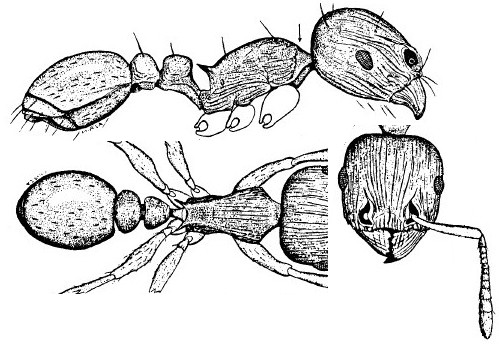 |
. | . |
| . | 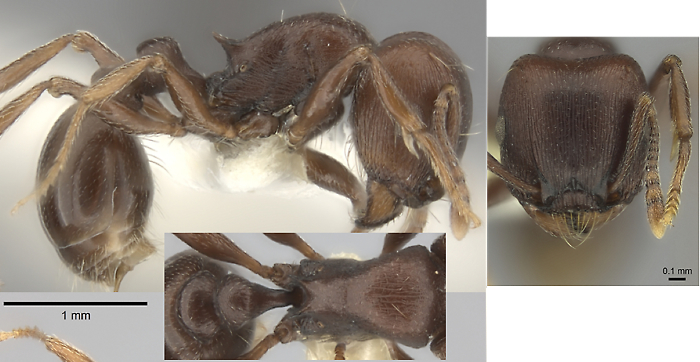 |
Tetramorium solidum | South Africa |
| - | No erect hairs on dorsum of alitrunk, pedicel or gaster | ||
| 28 | Without
propodeal spines; TL 5.3-5.8 mm; black or blackish-brown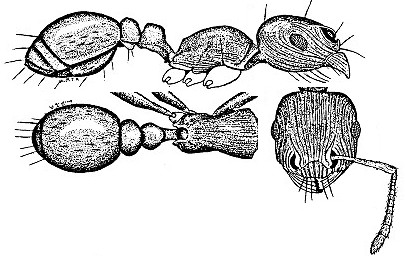 |
. | . |
| . | 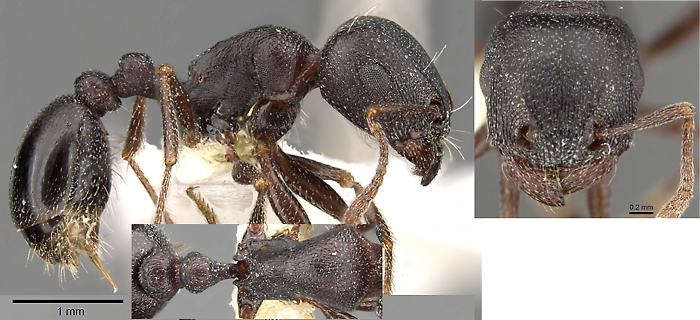 |
Tetramorium jordani | southern Africa |
| - | Propodeum with spines | ||
| 33 | Distinctive distorted pedicel
segments; TL 5.0-5.3 mm; deep reddish-brown to blackish-brown |
. | . |
| . | 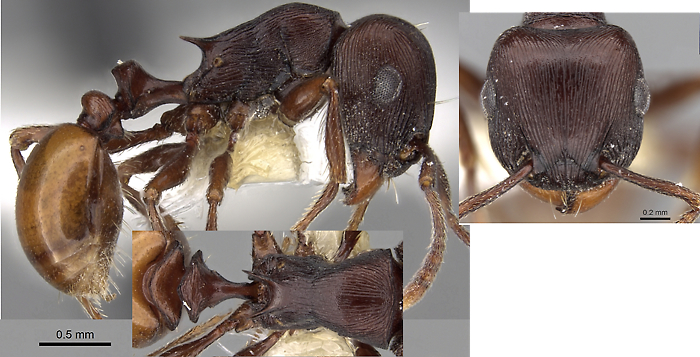 |
Tetramorium grandinode | South Africa |
| - | Petiole and postpetiole normal for group | ||
| - | Colour orange-red to darker red | ||
| 35 | Propodeal
spines very short, broad triangles; TL 5.0-5.7 mm  |
. | . |
| . | 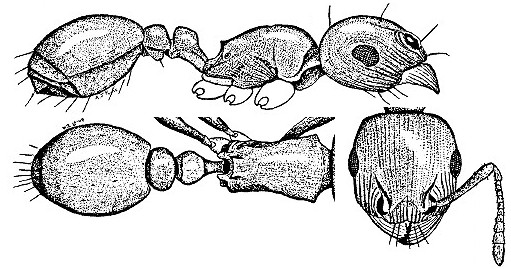 |
Tetramorium glabratum | southern
Africa |
| 35 | Propodeal spines long, much
longer than basal width; TL 4.0-5.1 mm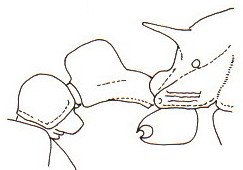 |
. | . |
| . | 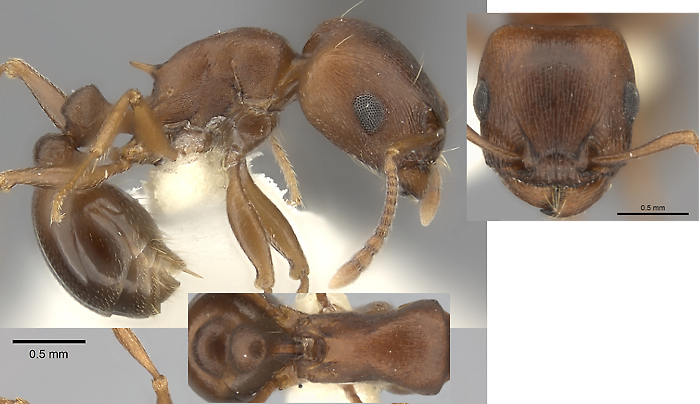 |
Tetramorium rufescens | Namibia |
| - | Colour brown or darker | ||
| 36 | Anterior
clypeal margin with broad concave median emargination; TL 4.4-5.3 mm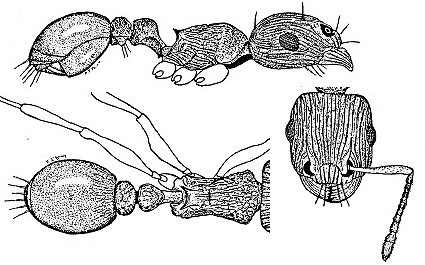 |
. | . |
| . |
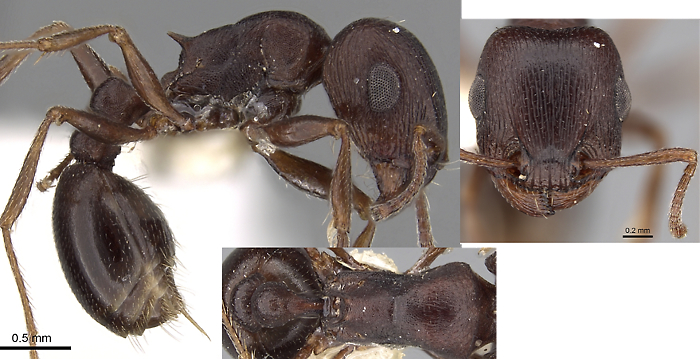 |
Tetramorium signatum | southern Africa |
| 37 | Anterior clypeal margin with
shallow concave median emargination; head narrowing anteriorly; TL
4.8-5.4 mm; blackish-brown |
. | . |
| . | 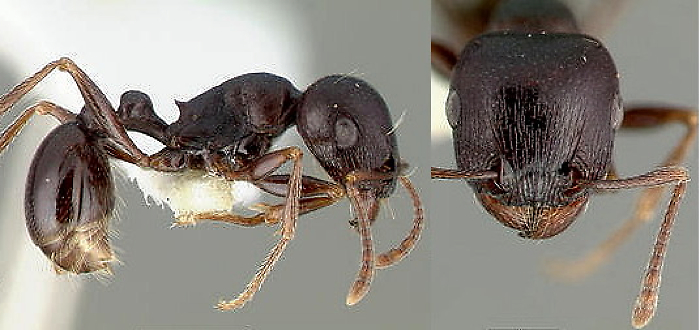 |
Tetramorium barbigerum | Namibia |
| 37 | Anterior
clypeal margin with shallow concave median emargination; head
parallel-sided; TL 3.8-4.1 mm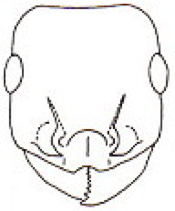 |
. | . |
| . | 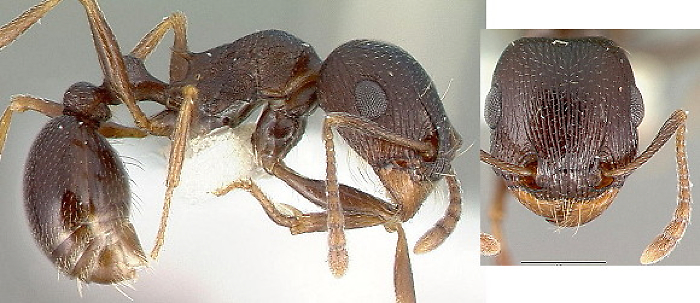 |
Tetramorium pogonion | Namibia |
| Anterior clypeal margin entire and ventral head without ammochaete hairs | |||
| Hairs
on dorsal alitrunk and/or first gastral tergite short, stout and blunt
apically; frontal carinae at most feeble; TL range 2.0-2.8 mm Otherwise |
|||
| simillimum-group - poweri-complex | - | ||
| - | Wholly without frontal carinae or scrobes | ||
| 108 | Very
small eyes; TL 2.2-2.2 mm; uniform yellowish-brown or light brown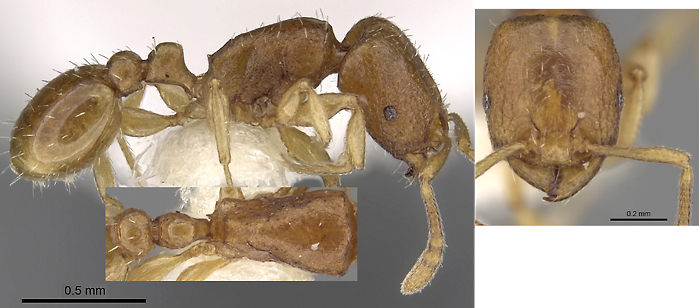 |
Tetramorium pauper | Kenya |
| 181 | Eyes with 6-8 ommatidia in
longest row; TL 2.6-2.8 mm; uniform dull yellowish-brown, gaster
slightly darker (note frontal carinae visible but very faint)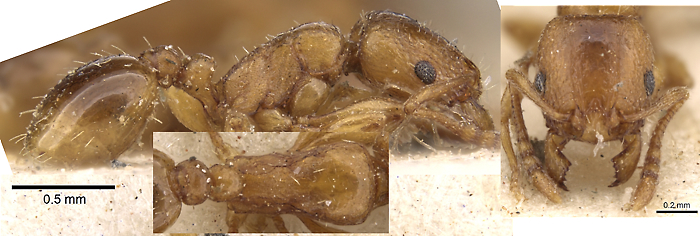 |
Tetramorium poweri | South Africa |
| - | Frontal carinae visible, basal one-third of first gastral tergite strongly sculptured | ||
| 180 | Side
of head with two projecting hairs behind the eye; eye 7 ommatidia long;
TL 2.2-2.3 mm; yellowish-brown |
. | |
| . |
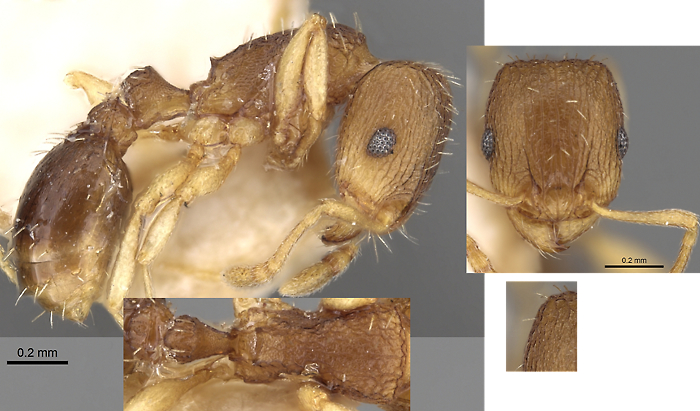 |
Tetramorium ghindanum | Ethiopia |
| 180 | Side of head with no projecting
hairs behind the eye; eye 9 ommatidia long; TL 2.0-2.1 mm; mid- to dark brown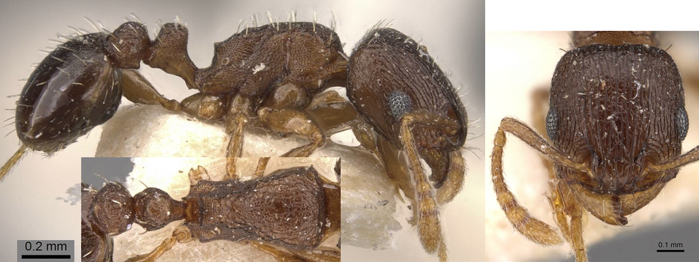 |
Tetramorium nefassitense | Ethiopia |
| - | Frontal carinae visible, basal one-third of first gastral tergite wholly smooth | ||
| - | Yellow to yellowish-brown | ||
| 175 &183 | Head
with distinct but fine longitudinal rugulae, spaces between smooth;
dorsal alitrunk with fine punctulate or or shagreened ground sculpture
overlaid by some fine longitudinal rugulae; TL 2.1-2.4 mm; some may be
darker to brown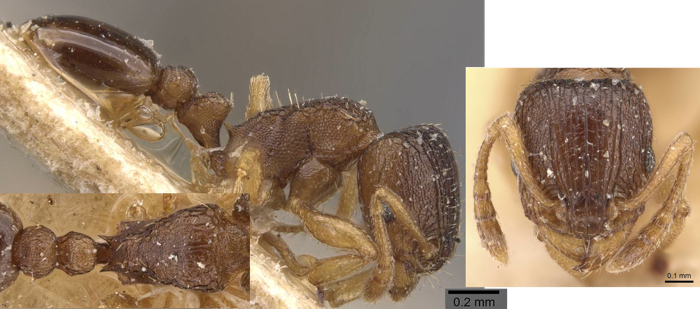 |
Tetramorium mossamedense | southern Africa |
| 183 | Head with weak longitudinal
rugulae, spaces between finely punctate or granular; TL 2.1-2.4 mm;
gaster usually darker |
Tetramorium caldarium | Sahel
savannah origin tramp species |
| . | 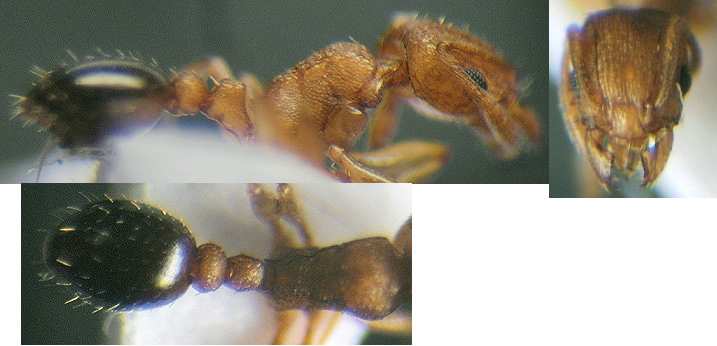 |
Narrow headed Congo Basin & tramp form. Gaster uniformly dark | . |
| . | 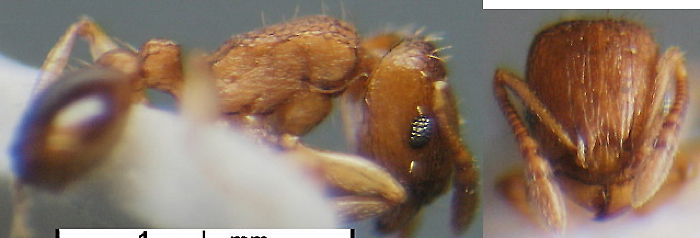 |
Broad-headed East African & Saudi Arabia form. Gaster with variable lighter areas | . |
| - | Rich dark brown to blackish-brown | ||
| 184 | Mandibles
smooth & shining; erect hairs short and blunt; petiole and
postpetiole almost smooth; TL 2.1-2.3 mm |
Tetramorium pusillum | South Africa |
| 185 | Mandibles longitudinally striate;
longer scapes (SI 84-91); propodeum with short triangular teeth; TL
2.6-2.7 mm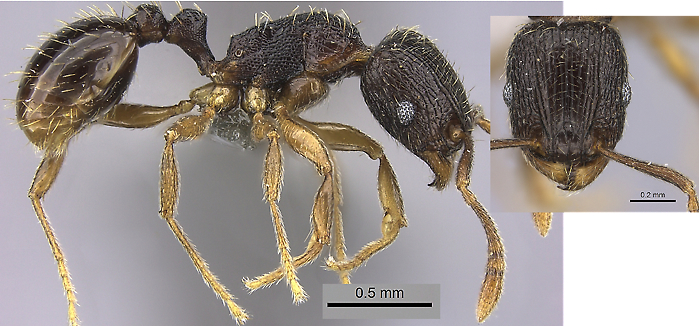 |
Tetramorium altivagans | Kenya &
southern Sudan montane |
| 185 | Mandibles
delicately striate; shorter scapes (SI 77); propodeum without teeth
merely angled; smaller TL 1.9 mm |
Tetramorium nigrum | Tanzania.
Kenya
& South Sudan (montane?) |
| Hairs on dorsal alitrunk and/or first
gastral tergite fine and acute apically or absent |
|||
| caespitum-group | Mandibles striate | ||
| 164 | probable exotic, TL 2.6-2.7 mm
(illustration is Tetramorium caespitum) |
Tetramorium nautarum | Annobon I. (probable introduction) |
| convexum-group | Mandibles smooth | ||
| 40 | Only
minute appressed hairs; TL 2.2-2.3 mm; uniform dull yellow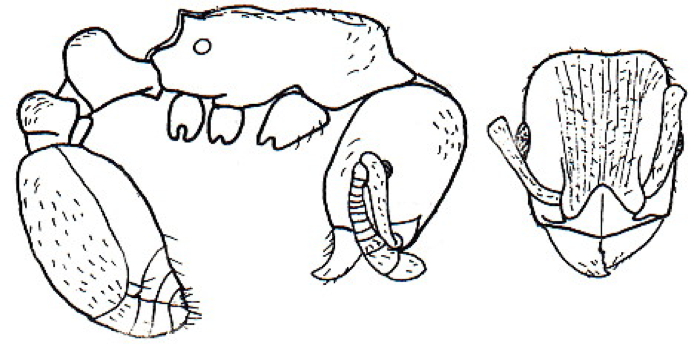 |
. | . |
| . |
 |
Tetramorium wadje | Ghana & Nigeria |
| 158 | With numerous fine hairs and no
propodeal armament; TL 1.9-2.0 mm; head dark brown, remainder dull
yellow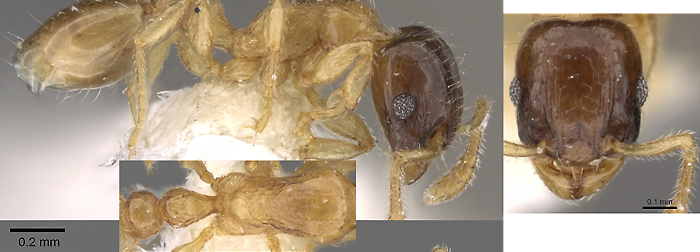 |
Tetramorium convexum | Ghana |
|
© 2007, 2008, 2010, 2011, 2013 - Brian Taylor CBiol
FSB FRES 11, Grazingfield, Wilford, Nottingham, NG11 7FN, U.K. |
href="tetramorium_groups_5.htm"